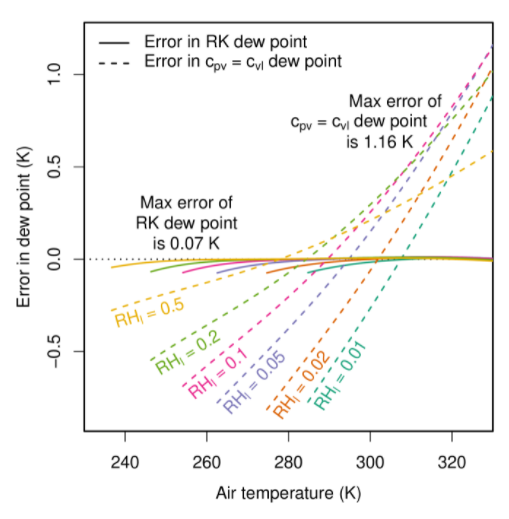Accurate and analytic expressions for the dew point and frost points
Submitter
Romps, David — Lawrence Berkeley National Laboratory
Area of Research
Radiation Processes
Journal Reference
Romps D 2021. "Accurate expressions for the dew point and frost point derived from the Rankine-Kirchhoff approximations." Journal of the Atmospheric Sciences, 78(7), 10.1175/JAS-D-20-0301.1.
Science

Figure 1. The error in the old (cpv=cvl) and new (RK) analytic expressions for the dew point relative to the empirical fit of Murphy and Koop (2005). From journal.
The dew point is the temperature to which air must be cooled at constant pressure for dew to form (or, more precisely, to reach saturation with respect to a plane of liquid water). It is a function of the air temperature and relative humidity, and it is usually calculated using a root solver that searches iteratively for the temperature that exactly produces saturation. While there is an explicit and analytic expression for the dew point in the literature, it produces errors as large as a Kelvin.
Impact
The work enlarges the set of analytic expression for moist thermodynamics derivable from the Rankine-Kirchhoff approximations. The Rankine-Kirchhoff (RK) approximations provide a self-consistent set of equations with which to describe the thermodynamics of moist air to a high degree of accuracy. The underlying approximations are that dry air and water vapor are ideal gases, that heat capacities are constant, and that condensates have zero specific volume. These approximations were used in an earlier paper on the lifting condensation level (LCL) to produce an expression for the lifting condensation level (LCL) that was explicit, analytic, and exact in the sense of having errors less than the empirical uncertainty.
Summary
In this short note, the Rankine-Kirchhoff approximations are used to generate explicit, analytic, and accurate expressions for the dew point and frost point. As shown in the figure, the existing analytic expression has errors as large as 1 K whereas the new dew-point expression is accurate to better than 0.07 K, which is comparable in magnitude to the uncertainties of laboratory measurements.
Keep up with the Atmospheric Observer
Updates on ARM news, events, and opportunities delivered to your inbox
ARM User Profile
ARM welcomes users from all institutions and nations. A free ARM user account is needed to access ARM data.


















